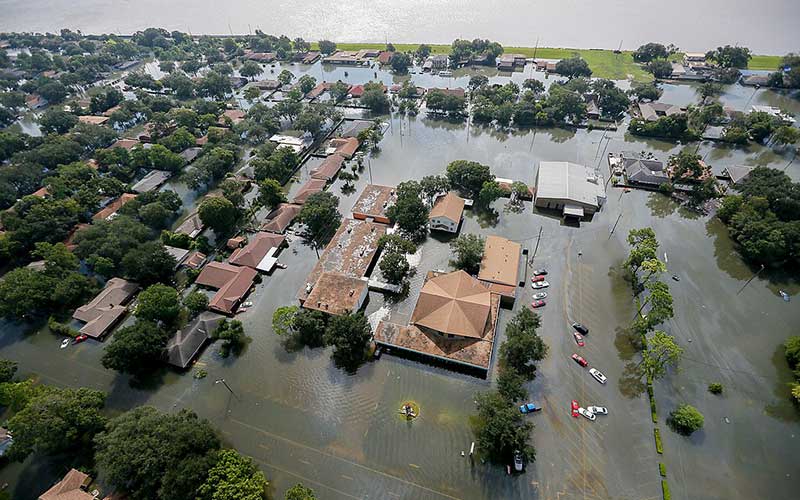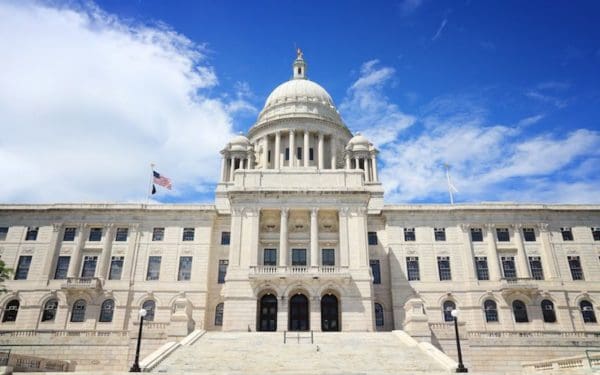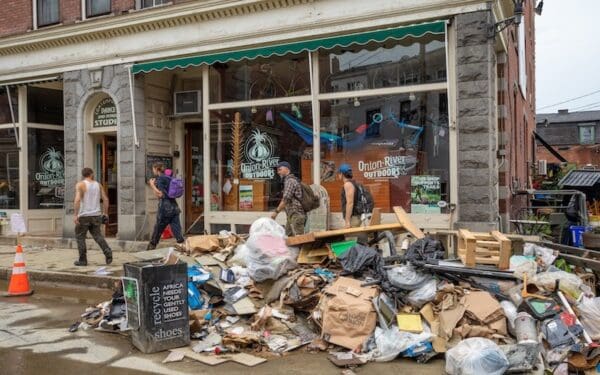
Hurricane Harvey put Houston neighborhoods under water. Is New England ready for when such extreme weather hits us here? Photo: SC National Guard
UPDATE: As we head into the Labor Day weekend, Florida is preparing for Hurricane Dorian – which could strengthen to a category four storm by Monday. While we call our loved ones down South with reminders to stay safe, it’s also time to revisit whether or not New England is ready for extreme weather. Our region has seen hurricanes and tropical storms before, but it doesn’t have to be a storm of that magnitude to do significant damage. Severe storms are becoming more common, and will only grow more frequent as the climate crisis deepens.
Just over a year ago, Hurricane Harvey crashed into the Texas coastline, pummeling Houston and dropping a record 60 inches of rain on the Lone Star State. When all was said and done, 103 people lost their lives, and damage estimates topped $125 billion.
Harvey kicked off a series of catastrophic hurricanes in 2017, and the communities they hit are still dealing with the impacts. Irma slammed into the U.S. Virgin Islands and Florida, costing $50 billion. And the people of Puerto Rico continue to experience the aftereffects of Hurricane Maria, which caused $90 billion in damages and was responsible for more than 3,000 deaths.
New England Is Not Immune from Extreme Weather
New England has not faced a direct hit from a hurricane in decades – the last hurricane to make landfall here was Hurricane Bob, which hit New Bedford directly in 1991. But we have experienced our share of extreme weather in recent years. Tropical Storm Irene inundated Vermont villages seven years ago, and Superstorm Sandy was a near-miss. Snowmageddon brought Boston to a standstill in 2015, and just last year, two bomb cyclones in six weeks flooded coastal streets up and down New England’s coast.
With the magnitude of tropical storms and hurricanes intensifying because of climate change, we know it is only a matter of time before New England sustains a direct hit or glancing blow that will impact the entire region. And with our changing climate causing disarray in our winter weather as well, we can expect more erratic extremes of snow and cold, and the icy floodwaters that come with them.
So, is New England ready for the storm like Hurricane Harvey we know is certainly coming? The answer is no. But we can take steps to get there.
Actions New England Should Take to Prepare for Future Storms
The fact is that climate change is happening, and while we continue to push policies to stem it, we at CLF also believe that we must work to mitigate its impact on our infrastructure, our economy, and our communities. Boston’s Seaport district is just one example of continued blind development in the face of known climate impacts. So what can we do?
Here’s a short list:
- Require new developments to take climate into account. Currently no laws or regulations anywhere in New England mandate climate-resilient design for development. To say that they are overdue is an understatement – that should be rectified as soon as possible.
- Update building codes now. We need serious updates to building codes along waterfronts and other at-risk areas, and those updates should be grounded in forward-looking data.
- Reform zoning codes. We need zoning reform that gives cities and towns the power to protect our floodplains and other at-risk areas.
- Collect and share the costs of extreme weather. We need consistent, open reporting of the costs associated with climate change. This will equip state and local agencies with the knowledge they need to make informed policy. It will also empower residents with important facts regarding the safety and financial risks associated with their homes.
- Fortify critical infrastructure and hazardous facilities. We need universal standards for the placement of hazardous waste and critical infrastructure, including utilities and chemical and fuel storage sites, which takes climate risk into consideration. Hurricanes Sandy and Harvey should be lesson enough that these facilities cannot be left unfortified on floodplains and other at-risk areas if we hope to prevent disaster.
This is the New Normal, and We Need to be Ready
Record-breaking temperatures, hurricanes, wildfires, tornadoes, and floods have become the norm on daily news feeds rather than the exception. But we are not helpless in the face of climate impacts. If every New England state took the five actions above, we could strengthen and prepare our communities, our economy, and our environment.
These actions can’t wait – the costs of doing nothing are too high.



